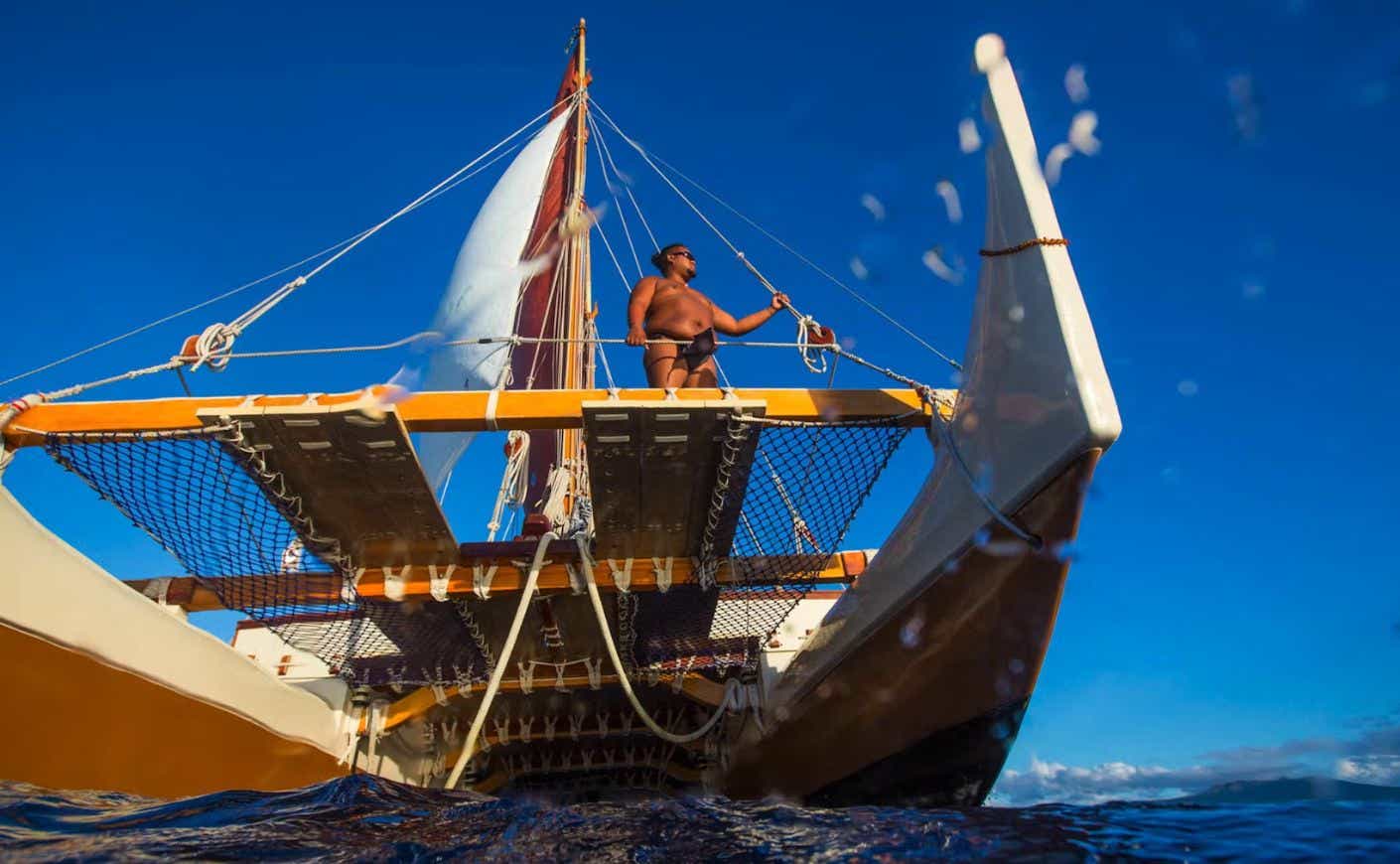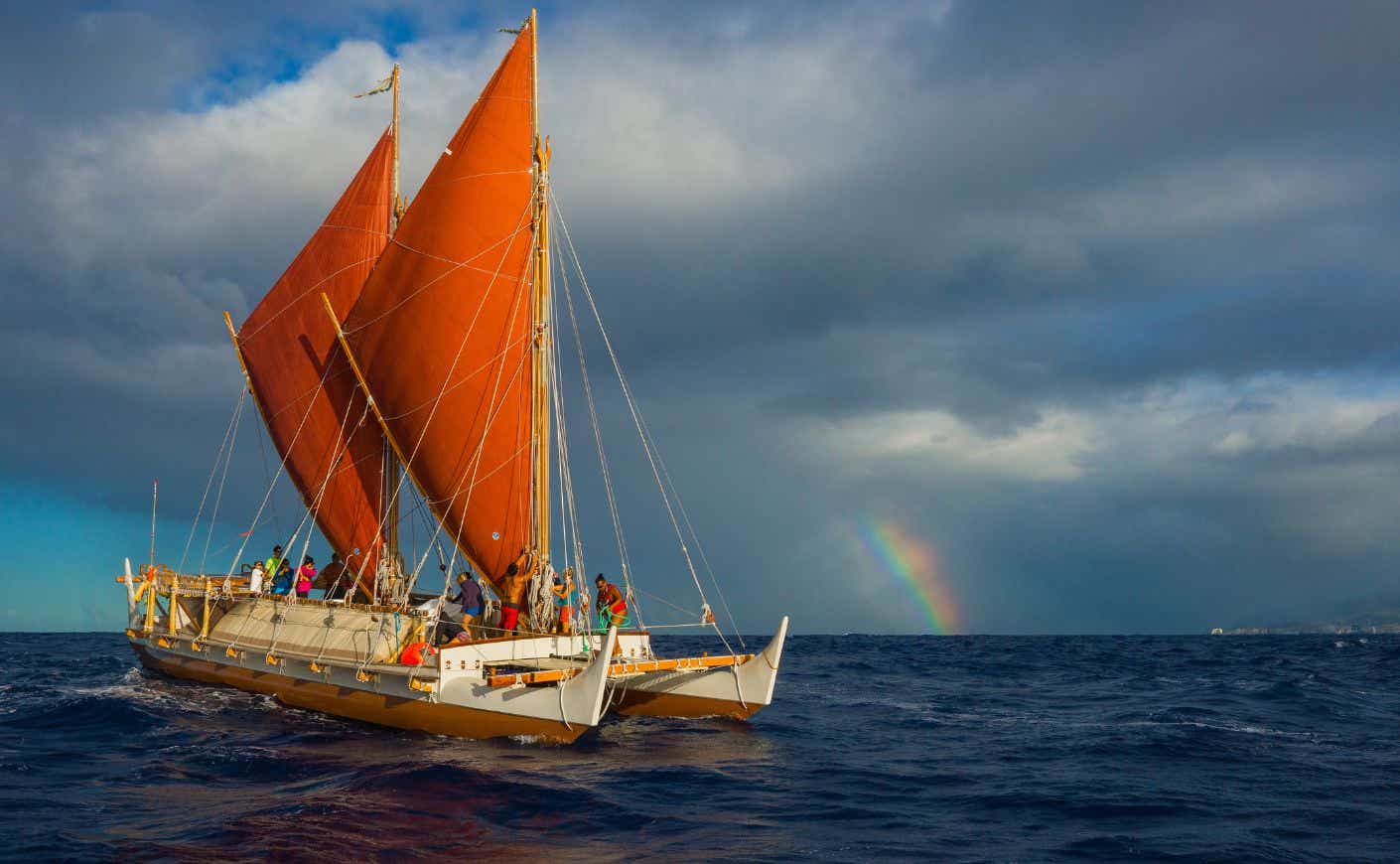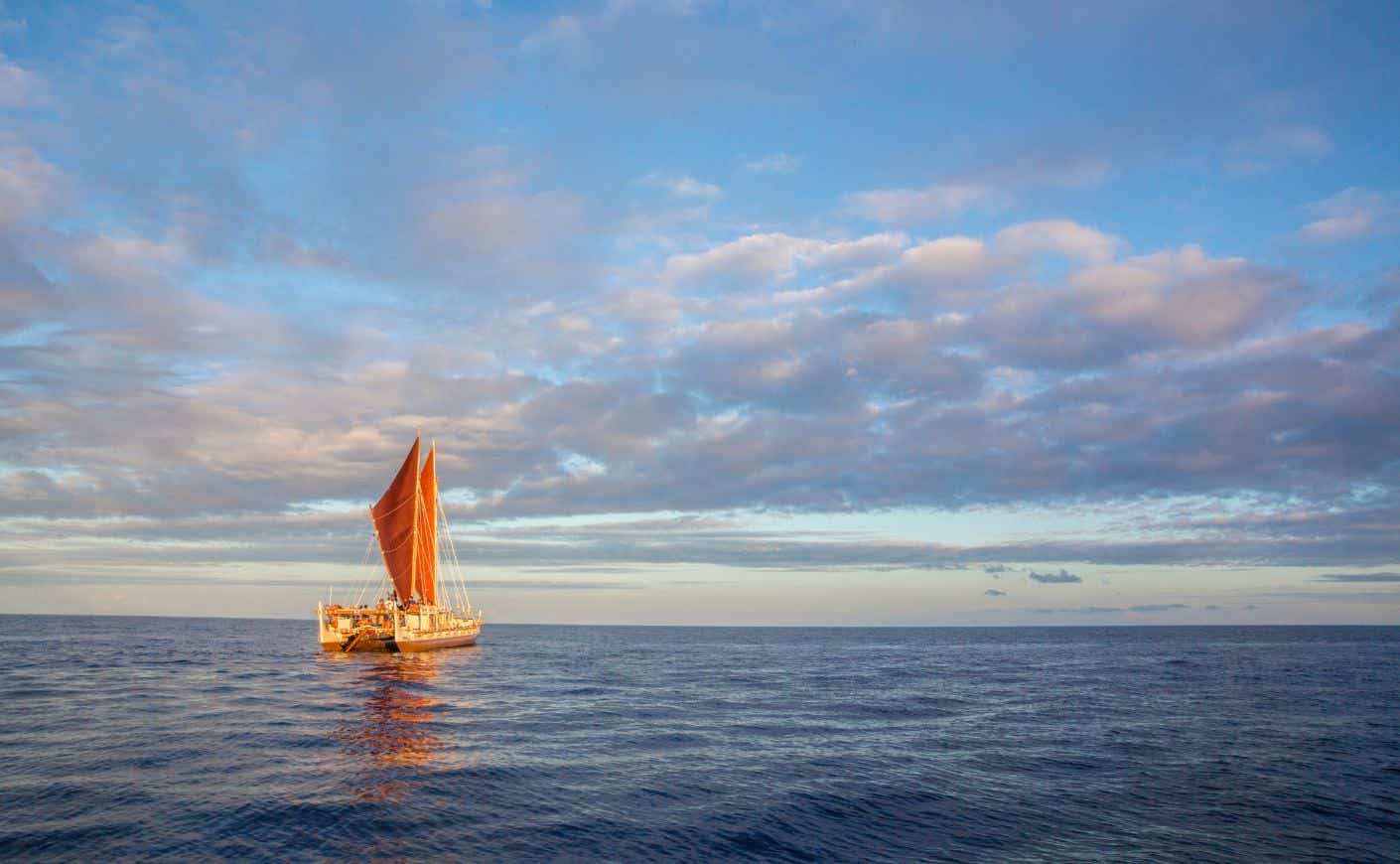It was still dark when my partner, Paul Nicklen, and I boarded Hōkūleʻa at the dock in Honolulu, where the double-hulled canoe was lovingly tended and readied by an all-Hawaiian crew. The cool morning air smelled of salt and damp wood. The canoe was smaller than I’d imagined — no cabins, no toilets. The young crew, made up of students under the guidance of master navigator Nainoa Thompson, moved in near silence, already communicating through the unique language of the sea, the subtle movements of human physicality being understood as innately as the motion of the waves below. As the sails filled, the canoe tugged free from the dock and slid into open water.
We were there on assignment for National Geographic, documenting the revival of ancient Hawaiian traditions and the people who keep them alive. Thompson, one of Hawai‘i’s most revered cultural leaders, stood barefoot at the bow, eyes on the horizon. He spoke softly to the crew, carrying the kind of authority earned not from power but from mastery. Watching him, I realized that knowledge doesn’t always live in books. Sometimes, it’s carried in the way someone moves, speaks, and lives.
Thompson is the first Hawaiian in centuries to navigate a canoe across the Pacific guided only by the stars, the sun, and the ocean itself. Polynesian wayfinding draws on a mental map of where hundreds of stars rise and set, allowing navigators to steer toward one as it lifts from the horizon and shift to the next as it climbs out of view. This celestial roadmap is paired with a deep understanding of the sea and wind. When clouds cover the sky, ocean swells and wind direction can hold a course for hours. And when even those cues disappear, the only safe choice is to wait and trust that the next opening in the sky will reveal the bearings again.
For thousands of years, Polynesian wayfinders used this knowledge to traverse the largest ocean on Earth, traveling tens of thousands of miles across scattered islands. For centuries, colonization tried to erase that knowledge. When the U.S. illegally overthrew the Hawaiian monarchy in 1893, Native Hawaiians lost nearly everything. Their traditions were banned, their waters militarized, and their dances and songs commercialized for tourists. However, in the 1970s, Hōkūleʻa became a vessel of return for Hawaiian culture.
The voyage that changed me
Named after a guiding star in Polynesian navigation, Hōkūleʻa launched in 1975 and became the beating heart of the Hawaiian Renaissance. At the time, only a few elders still remembered the ancient art of wayfinding; it was a tradition on the verge of disappearing. Her first voyage to Tahiti the following year rekindled that knowledge, proving to the world, and to Hawaiians themselves, that their ancestors were among the greatest navigators in history.
It was an honor for Paul and me to document this beautiful vessel, a replica from the sailing canoes that brought the original Hawaiians from Tahiti thousands of years ago. Once we were clear of shore, Paul climbed into a chase boat, camera in hand. He was determined to race ahead, jump in the water, and photograph Hōkūleʻa as she passed over him. I watched, half in awe and half in panic, praying the canoe wouldn’t clip his head. But Paul has an instinct for these moments, and he placed himself exactly where he needed to be.

Later, when the light softened, it was my turn. From the chase boat, I watched Hōkūleʻa glide beneath an arched rainbow, her sails catching the sky’s soft colors. The sea shimmered like molten gold. I raised my camera and felt the familiar stillness that comes just before the click.

Sailing on Hōkūleʻa changed me. It was when I truly understood that Indigenous knowledge isn’t an abstract concept preserved in time — it’s real and it’s alive. The last people still connected to the operating system of planet Earth are those who protect these systems of knowledge and belonging.
The power of the past
Western science teaches us about the world through precise measurements, models, and predictions. But Indigenous knowledge teaches us something equally profound. What an incredible feat it is to know every star, the stories they carry, and your place within them. To not just see the waves, but to read the ocean like a map. I often say that every politician should have a scientist on one side and an Indigenous leader on the other. And what better time to recall this sentiment than during Native American Heritage Month? Indigenous voices are essential if we hope to navigate what lies ahead.
Since her first voyage in 1976, Hōkūleʻa has circumnavigated the globe six times. Now, she embarks on her most ambitious journey yet, the Moananuiākea circumnavigation of the Pacific. Over four years, crews will sail to 36 countries and 300 ports, building a global network of navigators who understand that all of us, islander or not, are crew on the same canoe.
Just last week, she made landfall in Aotearoa (another name for New Zealand), greeted at the dock by Māori communities celebrating 40 years since her first arrival. You can continue to follow her journey online and witness the revival of one of humanity’s most extraordinary traditions. Each port she visits, each story she shares, is a reminder that the answers to our greatest crises may not lie solely in new inventions, but in ancient wisdom as well.
The same ocean that sustains us is turning against us — it’s heated, swollen, and angry. In the days after Hurricane Melissa tore through the Atlantic, I couldn’t stop thinking about islands — those fragile necklaces of sand and coral now half-drowned by the tides. The sea has always shaped islander culture, and they are now bearing the brunt of climate change and the legacy of human hubris, a belief that we can bend nature to our will. But as the wayfinders know, the ocean can swallow you whole.
Lessons from the sea
I’m honored to have recently joined Nainoa on the board of Nia Tero, an organization dedicated to supporting Indigenous Peoples’ stewardship. Their work recognizes what the Hōkūleʻa has always symbolized, that the people who live most closely with nature are also the ones best equipped to protect it.
My conversations with Nainoa these days often circle back to what he teaches at sea: “Earth is a canoe,” he says. “Unless we all paddle together, we won’t reach the shore.” For Nainoa, true navigation isn’t about control, but awareness. You look back to remember where you’ve been. You watch the horizon for what’s coming. You adjust.
We can’t afford to drift. The storms are real. The science is blunt. But hope is a lot like navigation. It begins when we leave behind the small comforts of denial and pick up a paddle, vote, speak, teach, rebuild, whatever your strength allows.When I close my eyes, I still see Hōkūleʻa cutting through the light, steady and deliberate. The world is our canoe now. The only way through is together.
Paul Nicklen and Cristina Mittermeier co-founded SeaLegacy in 2014. SeaLegacy’s mission is to inspire people to fall in love with the ocean, amplify a network of changemakers around the world, and catalyze hands-on diplomacy through hopeful, world-class visual storytelling. For more updates on their meaningful work, learn more about SeaLegacy, and subscribe to Ripple Effect, Katie Couric Media’s sustainability newsletter.









